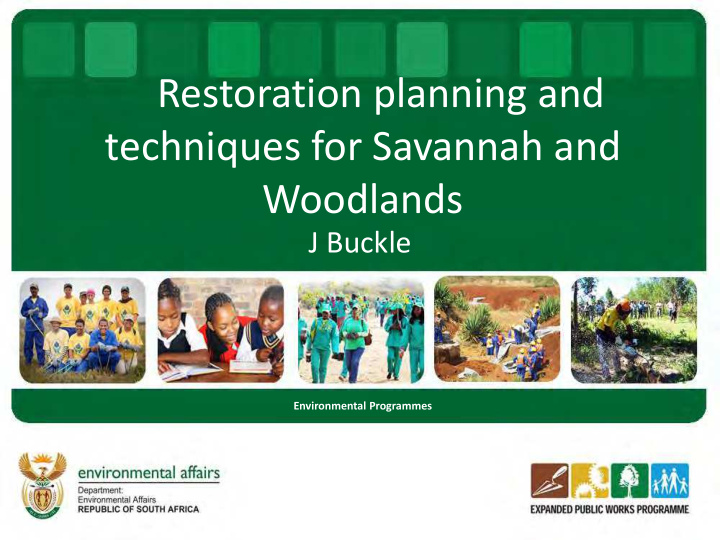



Restoration planning and techniques for Savannah and Woodlands J Buckle Environmental Programmes
Definition of savannah • A savanna or savannah is a mixed woodland grassland ecosystem c haracterised by the trees being sufficiently widely spaced so that the canopy does not close . The open canopy allows sufficient light to reach the ground to support an unbroken herbaceous layer consisting primarily of grasses
Definition of woodlands • Woodland is a low-density forest forming open habitats with plenty of sunlight and limited shade. Woodlands may support an understory of shrubs and herbaceous plants including grasses . Woodland may form a transition to shrubland under drier conditions or during early stages of primary or secondary succession. Higher density areas of trees with a largely closed canopy that provides extensive and nearly continuous shade are referred to as forests
Afro-tropic ecozone: woodland types • Miombo woodlands • Mopane woodlands • Kalahari Acacia-Baikiaea woodlands (Botswana, Namibia, South Africa, Zimbabwe) • Baikiaea woodlands (Angola, Botswana, Namibia, Zambia, Zimbabwe)
Degradation problems in Savannah and woodlands • Ongoing competition between the tree and grass layer components • Climate change promote tree root development. • Overgrazing of grass layer and/or tree layer • Result in Bush encroachment – bush thickening or open denuded sometimes treeless areas • Capped soils resulting in sheet and gully erosion • Role of fire – natural driver of ecosystem
Degraded Areas of the Country
Root and shoot Research by Dr Barney growth of sweet Kgope, Dr Guy Midgley thorn ( Acacia and a visibly concerned Karroo ) at Professor William Bond different (below) confirmed a parts-per-million potentially catastrophic of atmospheric link between climate change and habitat carbon dioxide modification – and one (CO 2 ). that will be exacerbated by woody invasive alien This will lead to plants. massive impacts on a productive use of land, water security, wild fires, biological diversity, and more. (Professor Guy Midgley)
The already problematic mesquite ( Prosopis species) in the Northern Cape are well-adapted to take advantage of climate change, with disastrous implications for rivers, keystone ecological species, groundwater and human livelihoods.
Open savanna in Eastern Cape in 1955. Bush Encroachment Trees have increased world-wide in the savannas, which is thought to be linked to differences in pre-industrial to current CO 2 levels. It has been exacerbated by poor farming (notably over-grazing) in certain areas, and by suppression of wild fires . The implications of this spread and growth of our indigenous tree species The same site in 1998. (and compounded by a similar spread and growth of invasive alien tree species) are once again disastrous for the ecological functioning of natural systems, biological diversity, water security, wild fires, soil erosion, siltation, grazing, the productive use of land, and the economy. (Professor Timm Hoffman, University of Cape Town)
Planning for rehabilitation • Understand the problem first. Lack of fires, over grazing, drought, local geology, soil and climate • The use of Google Earth maps to get an overall view of the area • Approach: Address the drivers of degradation first. Decide on the most appropriate method. Tackle the easy medium degraded areas first.
Dealing with bush encroachment
Dichrostachys cinerea - Sickle bush encroachment in SA
Mechanical Bush encroachment control in Namibia – Acacia mellifera
Using manual labour to do clearing of bush encroachment and brush packing
Removal of small trees and used for Brush packing on ponds - Limpopo
Fire as a tool to control bush encroachment
Veld condition surveys – bush thickening control • Know what the condition of the vegetation is before using fire as a tool. • Is there enough fine fuel (grass biomass) to carry a fire. • Weed/bush density. Different tree layers – kill small trees but keep larger/adult tall trees. • Indication of underlying problem: E.g. overgrazing, too frequent fires or suppression of wild fires. • Use in combination with other techniques – integrated approach to restore natural veld
Condition and amount of fuel
Successes: Erosion rehabilitation methods - NRM • DEA:NRM projects have done dryland rehabilitation work with some tested methodologies and are currently trying some new methods to improve the success rate • Projects include work done in the Baviaanskloof, Little Karoo, Ntabelanga and Mt Fletcher dam catchments, Marakele National Park, Golden Gate NP • Methods include: Re-sloping of gullies, silt fences, ponding and brush packing, use of soil blankets and soil sausages – addressing capped soils
What is soil capping (crusting), surface hardening, seal effect? • Any exposed soil (absence of good protective vegetation or basal cover) is subjected to the impact of raindrops . On impact the raindrops force the air out between soil particles and cause the top layer of exposed soil to become compact or denser – known as capping – cement like feeling of the exposed soil.
What is soil capping, surface hardening, seal effect? • Capped soils do not allow the water to infiltrate which will result in the increase of the runoff water, increase in velocity of runoff water, increase in erodibility • Result in erosion of the terrain.
Ponding with brush packing + regrassing
Ponding in the Karoo
Silt fencing around Gully erosion system – using Grassfence product
Gully re-sloping: Next - grass seed + soil blanket
I nstallation of soil blankets: overlapping
Applying of mulch after re-sloping of gullies
Training of teams to use the appropriate methodology for erosion control
Silt fencing, brush packing and re-grassing
Installation of soil blankets and soil rolls/sausages and ponding
Re-sloping gullies, install soil blankets, install silt fence & brush packing
Installation of Soil rolls/sausages
Rock packing
Case study to Thicket restoration approach
The good - 300,000 ha Semiarid solid thicket (characterized by a dense canopy of tall shrubs and a Portulacaria afra Jacq. component) - protect Courtesy Mills et al
The bad - 600,000 ha Moderately degraded by injudicious goat-farming - restore Courtesy Mills et al
The ugly - 800,000 ha Severely degraded by injudicious goat-farming – leave first Courtesy Mills et al
Spekboom planting on the contours
Thank You!!
Recommend
More recommend